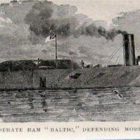Nanna Hubba Bluff
Nanna Hubba Bluff
10th of May 1865

Nanna Hubba Bluff is a bluff above the Tombigbee River near Calvert Alabama in northeastern Mobile County, Alabama, United States.
The historic site is known to have been occupied by Native Americans at least as far back as 1000 BC, but gained its name from the historic-era Nanibas tribe. The Nanibas (‘fish-eaters’) are believed by scholars to have been a Choctaw people. They occupied a village here during the early 18th century, until they moved downstream to the vicinity of Fort Louis de la Mobile and were absorbed into the Mobile tribe.
Following the relocation of the Nanibas, the bluff came to be settled by early European settlers. During the American Civil War the Confederacy had shipyards at the site. It was added to the National Register of Historic Places on October 1, 1974, due to its historical importance.

Commodore Ebenezer Farrand, in charge of Alabama’s naval forces, agreed to surrender at Citronelle. The surrender document was signed at Sidney Alabama on 4 May 1865, and according to the stipulations therein, Commodore Farrand’s designee, Lt. Julius Myers, surrendered at Nanna Hubba Bluff to Union Fleet Capt. Edward Simpson on the 10th of May 1865. Property surrendered included the Nashville, the Morgan, the Baltic, the Black Diamond, and the Southern Republic. Men paroled at the time included 112 officers, 285 enlisted men, and 24 marines. There is a partial list of these men in J. Thomas Scharf’s History of the Confederate States Navy.
Nanna Hubba Bluff was acquired by ThyssenKrupp in 2007, with the company building a new US$4.65 billion stainless and carbon steel facility on the site.
There is a little more interesting information at Running the Blockade
